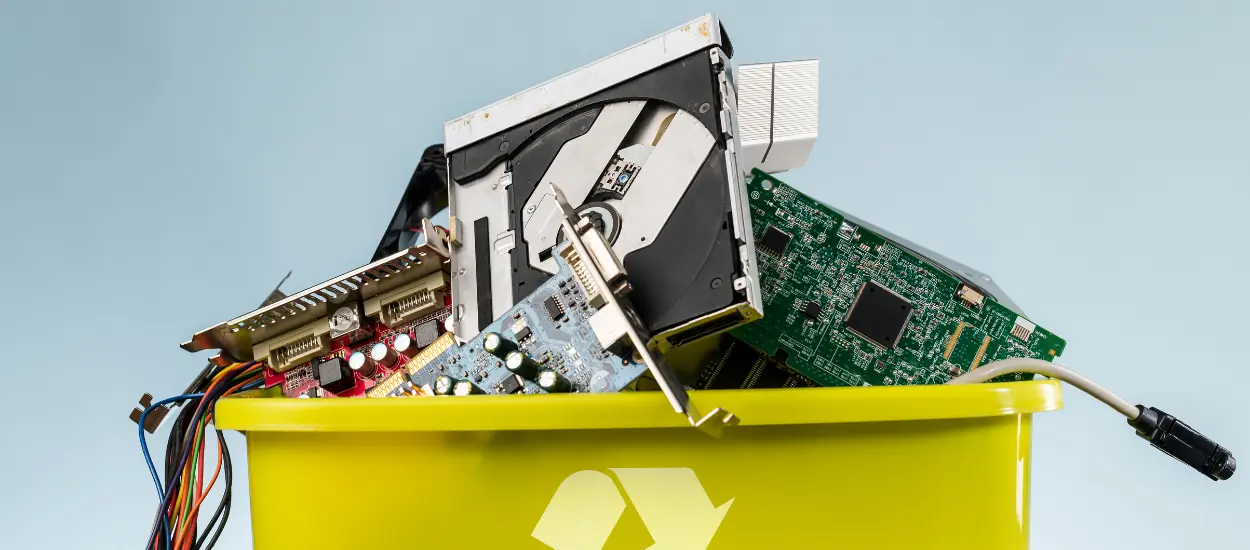
As the year wraps up, it’s the perfect time for IT departments to conduct a comprehensive audit and disposition of IT assets. This process helps clear out obsolete equipment, strengthens data security, and ensures compliance—all while supporting sustainability goals. Here’s a step-by-step guide to make your year-end IT asset audit and disposition efficient and effective.
America Recycles Day
America Recycles Day, celebrated on November 15, is a national initiative dedicated to promoting recycling and sustainability. This day serves as a reminder of the critical role recycling plays in conserving natural resources, saving energy, and reducing waste. By recycling, we can significantly cut down on greenhouse gas emissions and preserve valuable resources such as water and land. The impact of recycling is evident in the United States, where the recycling rate has grown from less than 7% in 1960 to 32% today. The goal is to further increase this rate to 50% by 2030, underscoring the importance of continued efforts in recycling and resource conservation. By participating in America Recycles Day, individuals and organizations alike can contribute to a more sustainable future.
The Importance of IT Asset Disposition (ITAD)
IT Asset Disposition (ITAD) is a vital process for organizations aiming to manage their electronic equipment responsibly and sustainably. ITAD encompasses the reuse, recycling, repurposing, repairing, or safe disposal of unwanted IT equipment. This process not only helps reduce electronic waste but also conserves natural resources and ensures data security. By partnering with ITAD vendors, organizations can benefit from secure data destruction and environmentally friendly e-waste recycling. This ensures that electronic equipment is disposed of in a manner that protects sensitive information and supports sustainability goals. Embracing ITAD practices is a crucial step towards responsible resource management and environmental stewardship.
Step 1: Conduct a Thorough IT Asset Inventory
Start by creating an up-to-date inventory of all IT assets, from computers and servers to mobile devices and peripherals. Identify items that are outdated, underused, or broken, as well as those nearing the end of their lifecycle. This inventory forms the foundation of your audit, allowing you to decide what needs to be retained, upgraded, or disposed of, including opportunities for computer recycling. Identifying large quantities of outdated or broken equipment can help in planning for efficient recycling or disposal.
Step 2: Evaluate Asset Condition and Data Security Risks
Once your inventory is complete, assess each asset’s condition. Look for signs of wear, outdated hardware, or security vulnerabilities that might impact performance or data integrity. This is also the time to identify devices that no longer meet security standards and could pose risks if not properly handled during disposition. Opting to recycle devices helps reduce e-waste while ensuring data security.
Step 3: Prioritizing Data Security with CompuCycle’s Certified Data Destruction Services
Before disposing of any IT assets, it’s critical to prioritize data security, particularly for devices that store sensitive information. CompuCycle offers a range of certified data destruction methods designed to safeguard your organization’s data while ensuring compliance with industry regulations. Here’s how CompuCycle’s services can make a difference:
- Data Wiping: For devices that can be reused or repurposed, CompuCycle uses secure data wiping software to permanently erase information, meeting stringent data protection standards.
- Physical Destruction: For obsolete or damaged devices, CompuCycle provides options like hard drive shredding and degaussing. These methods guarantee that data cannot be recovered, ensuring complete security and peace of mind.
CompuCycle’s certified data destruction services protect organizations from potential data breaches, mitigate the risks associated with improper disposal, and ensure compliance with regulatory standards. Partnering with CompuCycle means choosing a responsible, secure, and sustainable solution for IT asset disposition.
Step 4: Decide on Disposal, Recycle, or IT Asset Value Recovery
With data secured, choose the appropriate disposition path for each asset:
- Recycling: Non-functional assets should be recycled through certified e-waste recyclers who meet environmental standards. Understanding what can be placed in a recycling bin is crucial to promote effective recycling habits and enhance community efforts and overall recycling rates.
- Refurbishment: Some assets may still hold value if refurbished, allowing you to recover costs or redeploy within your organization.
Effective Asset Management
Effective asset management is essential for organizations to optimize the use of their IT assets and minimize waste. This involves comprehensive tracking and management of IT assets throughout their lifecycle, from procurement to disposal. Application lifecycle management (ALM) is a key component of this process, helping organizations manage the entire lifecycle of their IT assets, from development to retirement. By implementing robust asset management practices, organizations can reduce waste, save energy, and conserve valuable resources. This not only enhances operational efficiency but also supports sustainability initiatives by ensuring that resources are used judiciously and responsibly.
Step 5: Partner with a Certified ITAD Provider to Recover Valuable Resources
Partnering with CompuCycle, a certified IT asset disposition (ITAD) provider, ensures that your IT assets are responsibly managed from start to finish. CompuCycle holds certifications that demonstrate a commitment to regulatory compliance, data security, and environmental sustainability, including e-Stewards and ISO standards. With in-house processing, CompuCycle expertly handles secure data destruction, sustainable electronics recycling, and compliant IT asset disposition. This comprehensive approach provides organizations with peace of mind, knowing their assets are processed responsibly while meeting both industry standards and environmental regulations.
Step 6: Document the Audit and Disposition Process
Proper documentation of IT asset disposition is essential for any organization’s compliance and data security efforts. CompuCycle offers comprehensive IT asset tagging, tracking, and reporting services to streamline this process, providing clients with clear and detailed records of each asset’s lifecycle. From initial pickup to final disposition, CompuCycle ensures that every asset is tracked and accounted for, with full transparency around data destruction, recycling, and redeployment.
With asset tagging and tracking, organizations can access detailed reports on the status and location of each device, including certificates of data destruction, recycling records, and even documentation for charitable donations if applicable. This meticulous record-keeping aids compliance, supports data security protocols, and establishes a verifiable asset trail for future audits. It’s a critical step for organizations focused on protecting data, meeting regulatory standards, and ensuring environmental responsibility.
Benefits of Responsible IT Asset Disposal
Responsible IT asset disposal not only protects sensitive data but also minimizes electronic waste and conserves natural resources. By partnering with an ITAD provider like CompuCycle, organizations can ensure environmentally friendly disposal methods that prevent data breaches, align with regulatory compliance, and reduce their carbon footprint. CompuCycle’s sustainable practices support resource conservation, from reducing e-waste to promoting the reuse of valuable materials, ultimately helping organizations contribute to a cleaner, safer environment.
Step 7: Reflect and Plan for the New Year
Use insights gained from this year-end audit to improve IT asset management practices. Implement or update tracking methods, enhance data security protocols, and set guidelines for the upcoming year’s lifecycle management.
Houston IT managers seeking to make a meaningful impact can rely on CompuCycle’s certified electronic disposal and data center decommissioning services. By partnering with CompuCycle, you’ll ensure that outdated electronics are handled responsibly, from secure data destruction to eco-friendly recycling practices that align with both industry standards and environmental regulations. A year-end cleanout not only enhances data security and operational efficiency but also strengthens your organization’s sustainability commitment. Make this America Recycles Day count—contact CompuCycle today to schedule a pick-up and set the stage for a greener, more sustainable new year!
Excited to learn more? Explore our other informative blog articles!
- How ITAD and Cybersecurity Work Together to Reduce the Impact of Insider Threats
- When to Choose Data Sanitization Over Data Destruction: A Guide to Data Lifecycle Management for IT Managers
Learn more about CompuCycle’s IT Asset Disposal and secure data destruction services. For more information, visit CompuCycle.com, contact us online or call us at (713) 869-6700 to schedule a tour of our facility.
Recent Articles
CompuCycle Becomes Exclusive Woman-Owned E-Waste Processor in Texas with ISO 27001 Data Security Certification
New Information Security Management System (ISMS) Certification Guarantees End-to-End Data Confidentiality and Integrity for Corporate IT Asset Disposition (ITAD). HOUSTON, TX – December 9, 2025 – CompuCycle, an industry leader in secure and sustainable IT…
Read MoreSecure Electronics Disposal in Houston: Why the City’s Largest Industries Trust CompuCycle
When a major healthcare system decommissions thousands of laptops, or an oil and gas company retires an entire data center, one question comes up again and again: What happens to all that data — and…
Read MoreCompuCycle Executives Join R2 TAC and e-Stewards Leadership Council to Advance ITAD Standards
Houston-based ITAD provider deepens its industry influence through active participation in standard-setting committees. As corporate ITAD needs evolve alongside stricter compliance and ESG requirements, CompuCycle continues to lead the way—this time by contributing directly to…
Read MoreI’m Just a Computer: A Journey Through ITAD Recycling
Meet Chip the Computer – he’s about to take you on an unforgettable journey through the world of IT Asset Disposition (ITAD). Buckle up for an adventure that’s both educational and entertaining! Chapter 1: “Hello,…
Read More


